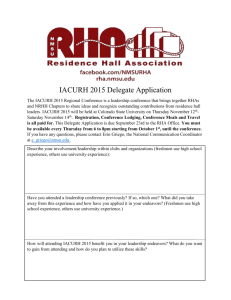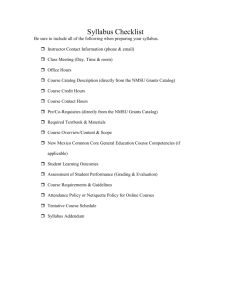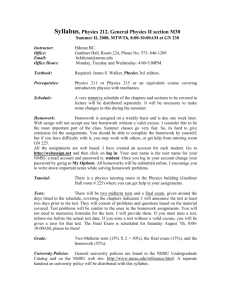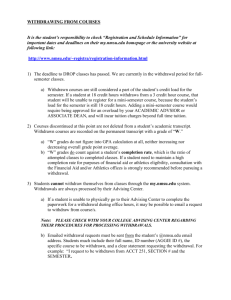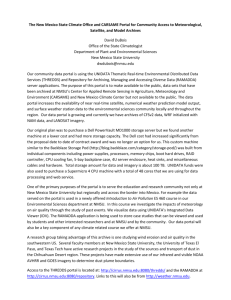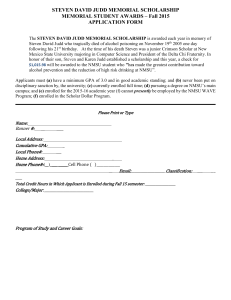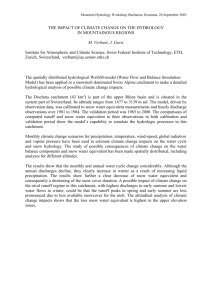Watershed, Climate, Hydrology Modeling Joint Projects of NMSU
advertisement
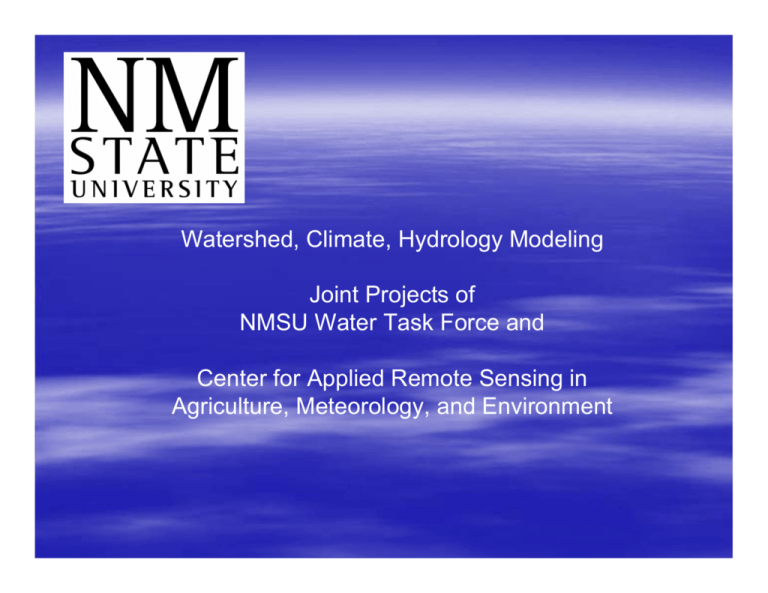
Watershed, Climate, Hydrology Modeling Joint Projects of NMSU Water Task Force and Center for Applied Remote Sensing in Agriculture, Meteorology, and Environment Purpose A cooperative effort focused on advancing the use of earth observation (EO) data as an essential element of natural resource management and related disciplines. To develop and apply the tools necessary for the next generation farmer, rancher, civilian, soldier. Partners Ft. Bliss CARSAME New Mexico State University – College of Agriculture & Home Economics – Water Task Force – Physical Science Laboratory – New Mexico Space Grant Consortium US Army Research Laboratory – Battlefield Environment Division US Army Ft. Bliss – Directorate of Environment USDA Agricultural Research Service – Jornada Experimental Range Customers CARSAME Agricultural Community Academic – Education, Research and Outreach Federal, State, and Local Agencies Natural Resource Managers Water Users “Our” Region CARSAME •Upper and Middle Rio Grande Drainages •Chihuahuan Desert Applications CARSAME Water management Air quality Natural hazards monitoring Agricultural production Battlefield environment Technology transfer Wildfire Research Range Management Water Management Issues: • Increasing user demand • Economic development • Limited and highly variable water resource • Competing demands • Unknown resource quantity • Trans-border compacts CARSAME Water Management CARSAME Solutions : • • • • • Snowmelt Runoff Models (SRM) Empirical Modeling Surface Hydrology Models (SLURP) Mesoscale Meteorological Models (MM5) Water Conservation through crop models and land-use planning (REEM) • Soil Moisture Monitoring • Drought Detection, Monitoring, Forecasting Water Management CARSAME Snowmelt Runoff Model (SRM): Goal: Provide improved module for SLURP and use as “stand alone” early season forecast tool Collaboration with: – Martinec (Switzerland) – Rango (USDA/ARS-JER) – Gomez-Landesa (NMSU) – Landis (BOR-El Paso) – Kite (HydroSolutions-U.K.) Snowmelt Runoff Model (SRM): Details: •SRM is a simple degree-day model that requires remote sensing input in the form of basin or zonal snow cover extent. Model variables are derived from actual observations of temperature, precipitation, and snow covered area. •The model has been applied by various agencies, institutes and universities in well over 100 basins situated in 25 different countries. •The average R2 for daily flows is reported as 0.84 and the average seasonal difference, Dv , is reported as 3.8% . For the Rio Grande Basin above Del Norte, Colorado, there have been several studies performed using SRM. For a ten-year period from 1973-1979 and 1982-1984, simulations showed that R2 was 0.86, and Dv was 1.7%. MODIS Snow April 16, 2003 May 22, 2003 July 08, 2003 Snowmelt Runoff Model (SRM): RG1 2002 SRM Fore cas t Rio Grande at De l Norte , 3,414.5 k m 2 RG1 2001 SRM Fore cas t Rio Grande at De l Norte , 3,414.5 k m 2 180 Forecas ted 160 Meas ured Forecas ted 160 Meas ured 140 daily discharge m 3 /s daily discharge m 3 /s 140 180 120 100 80 60 40 20 120 100 80 60 40 20 0 0 0 30 60 90 120 150 180 0 30 days f rom 1 A pril to 30 September 60 90 120 150 days f rom 1 A pril to 30 September Forecast 2001: Forecast 2002: • Obtained from conditions of an average year: 1976 (temperature and precipitation) • Obtained from conditions of a dry year: 1977 (temperature and precipitation) • Snow cover derived from 2001 conditions measured by satellite snow maps • Snow cover derived from 2002 conditions measured by satellite snow maps • Needs correction for reservoir storage • Needs correction for reservoir storage 180 Semi-distributed Land-Use Runoff Processes model (SLURP): Goal: Provide basin-wide Decision Support System (DSS) Collaboration with: – Kite (UK) – Rango (USDA-JER) – BOR-El Paso Semi-distributed Land Use Processes (SLURP): Details: •A basin model that simulates natural and modified hydrology and can be used to solve water resources management problems. •The SLURP model has been applied to basins varying from a few hectares to millions of km2 in many different countries. •Continual development since the early 70s by Dr. Geoff Kite •Links models at farm, irrigation scheme and basin scales. •Calculates productivity indices. •Produces basin-wide evaporation and transpiration maps. •Simulates overall basin functioning Semi-distributed Land Use Processes (SLURP): Input Parameters: Remote Sensing •Landcover/Landuse •NDVI Climatological •Tave •Rnet •Precipitation •Average Wind •Dew Point Digital Elevation Models Dams and Diversions Operating Rules Semi-distributed Land-Use Run-off Process (SLURP) Assesses current water distribution within a watershed using satellite imagery of vegetative land cover, runoff, elevation, precipitation, ET, infiltration/percolation, climatic conditions & diversions. Benefits to NM: Water Rights Adjudication support What-if scenarios for resource planning Sub-basin scale management Irrigation district allocations Precipitation Interception Canopy Storage Sublimation Snowmelt Evapotranspiration Snow Storage Runoff Fast Storage Infiltration Interflow Percolation Slow Storage Groundwaterflow Semi-distributed Land Use Processes (SLURP) Rio Grande above El Paso with major sub-basins currently being tested and validated MM5: Mesoscale Meteorolgical Forecast Model Domain 1 – 30km grid Domain 2 – 10 km grid Hardware System: • Intel Pentium 4, 1.7GHz • 1GB Memory • 7, 36GB SCSI Hard Drives • LINUX Red Hat 7.2 Surface observations for real-time updates to MM5 and near-term forecasts to integrats With SLURP: UNIDATA-LDM MESOWEST NEXRAD Being developed for real-time updates and very short range forecasting capabilities Regional Evapotranspiration Model (REEM) Goal: Provide operational, real-time estimates of evapotranspiration at the sub-field scale – eventually could be used for irrigation scheduling to more effectively manage irrigation supplies and optimize crop yields Details: Based on satellite remote sensing (NASA) Based on similar technology that is used on the Snake River in Idaho (SEBAL) for adjudication purposes and in Europe for operational applications to conserve water Preliminary results very promising Regional Evapotranspiration Model (REEM): LST + NDVI + ALBEDO = Regional Evapotranspiration Model (REEM): Measured & Calculated ET, PECAN-2002 9 ET,Measured ET, Cal. REEM 8 6 5 4 3 2 1 0 0 50 100 150 200 250 300 Julian Day Alfalfa ET, 2002 350 10 ET, Measured ET, Calculated 9 8 7 ET,mm/day ET, mm/day 7 6 5 4 3 2 1 0 0 50 100 150 200 Julian days 250 300 350 NMSU-CAHE Contacts Robert Sanderson GIS Remote Sensing 505-646-3225 bsanders@nmsu.edu http://eppws.nmsu.edu Ted Sammis State Climatologist 505-646-2104 tsammis@nmsu.edu http://weather.nmsu.edu Craig Runyan Water Quality Coordinator 505-646-1131 crunyan@nmsu.edu http://spectre.nmsu.edu/watertaskforce/ Max Bleiweiss Adjunct Science Specialist 505-646-2828 mbleiwei@arl.army.mil http://carsame.nmsu.edu Al Rango Research Hydrologist 505-646-2120 alrango@nmsu.edu http://usda.ars.nmsu.edu
